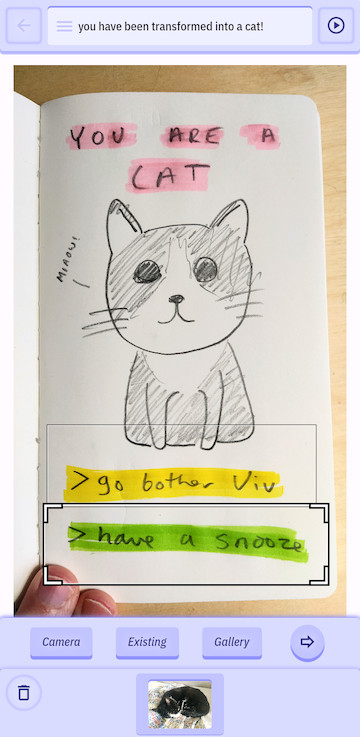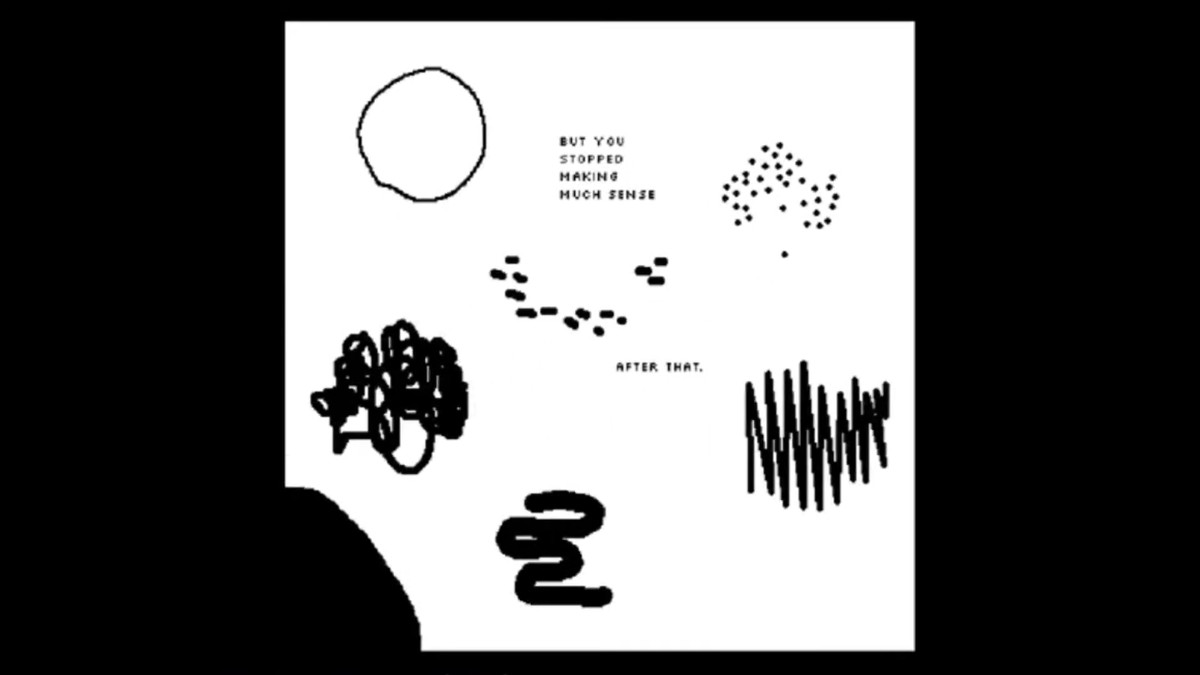Downpour is a design tool for more approachable games

V Buckenham pulled up the Downpour app during our Zoom call Friday, and within a few seconds, we were making a game. Buckenham snapped photos of our faces on the screen, then turned the camera on themselves for a selfie. Buckenham was able to link these images together with a few taps of their smartphone and created a game from them. It wasn’t their best game but it was an enjoyable experience.
“The idea is that you can be waiting at a bus stop, download [Downpour], and then by the time you get off your bus at the other end, you’ll have made a game and released it,” Buckenham said. “That’s the kind of thing I want to be possible.”
Buckenham, the founder of Downpour Limited, is part of a community of creators making game design tools with an aim towards making game design more accessible, approachable, and creative. They said it’s not necessarily the singular future of video games, but one of many futures: an option for creators looking to do something different, not a replacement for traditional game-making methods.
Polygon spoke to Buckenham via Zoom last week to chat about this community of creators making new tools — including Downpour, which Buckenham hopes will come out this year.
[Ed. note: This interview has been edited for length and clarity.]
Polygon: I’d love to start by hearing about you and your history in the video game industry.
V Buckenham: I’ve been around the games industry for about 10 years, around the indie space. I worked with Die Gute Fabrik on Mutazione, which you might know — many, many years ago, because that was in development for years. I worked at a start-up called Sensible Object on a game called Beasts of Balance, which was a digital and physical stacking game. Niantic acquired the company, and I was able to work on things that are still unknown.
Basically, I was there long enough to earn money to buy a house and put together some savings. I left to go do my own things. While I have been working on several things since then, Downpour has been my main focus. The other thing, which is not actually video games, but it’s pretty relevant to Downpour, is that I was involved in the Twitter bot community around five to seven years ago and made a site called Cheap Bots Done Quick. There’s, like, tens of thousands of people using it to host Twitter bots. That’s my biggest, most notable creative tool. I think the fact that I’d made that gives me a lot of confidence that I can make something and it’s going to find users. This will allow people to achieve things that they wouldn’t otherwise be able to.

Image: Downpour
What is Downpour? What is Downpour?
Downpour is a tool for making games quickly and approachably. You can download Downpour while you wait at a bus stop and release it when you reach the other side. This is what I would like to see happen. It’s just a way of saying that it can be done faster but the amount of things you will make is limited. I don’t know if you know HyperCard, this ancient MacOS thing, but basically if you have an image and you can link bits of that image to other images, there’s a lot you can do with that. You can do a lot with it. You can also use it to create your games by drawing on paper and making silly faces. That just feels much more tactile than doing it on a computer, and it means you can spend time outside of that. We all have smartphones and cameras so we can use it in ways that you wouldn’t otherwise be able to. It was particularly important to think about teenagers, who may not have access to a laptop or other tech.
The bit that’s missing from this [right now] is a button that you can press and then it uploads to my servers, and you can share [your game] immediately. Although there are many other functions I should be focusing on, this is the core of it.
Why is it important to you to make game design more approachable? Downpour seems to be based on Bitsy’s experience with Twine and Twine.
Honestly, with all the things going on right now, I don’t know if I can justify it as actually important. It’s great to watch people make stuff. That brings joy. And if I can make people make more things … the feeling of making an approachable tool and someone does something with it, and you’re like, ‘Wow, that’s really cool. That’s something I wouldn’t have thought of. It’s difficult to match the joy that you can see in others and how they make an impact. That’s great.
Do you think that approachable game-making tools are sort of the future of games? Do you think that game-making tools are the future of games?
No, I mean, it’s a future. It’s clear that expensive items will continue to exist. Indie games in particular categories are becoming more costly to produce. But there’s also people making things that weren’t here before, but that feels like a thing.
So, you know, I don’t know. Roblox is going in both directions simultaneously, right? It’s easier than ever to make a game. There are professionalized games. I think all this stuff can coexist.
When you showed the tool at Now Play This, were there any games or experiences that came out of that were especially unique or surprising to you? You must find it exciting to see the results of this tool.
Yeah, a couple things that were pretty cool. The other was stop motion. There’s one that’s like, just basically a turtle going through a door. Another one that’s slightly cheating, because it was done by Joe who is one of the organizers of Now Play This, who was able to detach the tablet and wander around with it. But basically, he did a walkthrough of the festival, like going through all the doors and all kinds of stuff. There’s a thing about taking pictures in 3D space, like it’s a 3D scan of your environment that you can walk around in, like the kind of thing people did with that weird house that was a warehouse that was previously a church. I even went to that in VR Chat.
There’s that, and then there’s the low-tech thing of taking photos and linking it together and getting that weird, actually really 3D sense of being in a space. It’s quite exciting to see that this is possible.
Is there anything that you’ve made using Downpour that you’re particularly proud of?
I did this thread [of games] as a way to force me into actually making it. Because once I’m making it, I’m in tunnel mode and it’s hard to shift to actually using it. The one I’m probably most proud of is the Pluto one, just because I think blink comparators are really cool, just using that technique and flicking between code and seeing what’s changed. It’s great to be able share this stuff.
Also, I’m not necessarily recommending anyone looks at it, [but I made one when] I had a tooth extracted. Then I just sort of threw it out there and started posting pictures, in a personal way, of the tooth. It has a certain amount of playfulness in just, ‘Don’t click here,’ and then you click here, and making that approachable. I’m on Mastodon, and it was definitely an inspiration for this kind of thing being on there and seeing the way that the content warning feature can be used for jokes. This is the setup. You just need to click one button. When you click the button, you see the punchline. But the fact that you clicked it makes you responsible for seeing the punch line in a way that makes things fun. It’s quite inspiring to be able put in jokes.
You’ve talked a bit before about flatgames being an inspiration for the tool. I’d never heard the term flatgames before.

Image: Jenny Jiao Hsia
Yeah, this is a movement I’d seen around, and seen some exciting stuff, like some of Llaura [McGee’s] early games. There was the Flatgame Jam. And Jenny Jiao Hsia’s and i made sure to hold your head sideways. This game is incredible. But yeah, it’s just just a style of here’s how we can make stuff more approachable, especially in that assets should ideally be made on paper.
Making stuff on paper feels really great. But then there’s this sticky bit in the middle where I have to get stuff into the computer. Then I need to create scripts in Unity. Yes, Unity can handle scripts. It’s just too difficult for technical reasons. The other part of that is that we had flatgame stuff at Now Play This in the past, and seeing people get really into it. The setup there was that people were drawing on pieces of paper and they were being scanned using this tool that someone had made. That was really good. People were putting together games using the stuff that was made by it. That kind of showing how stuff is made and making it more approachable is great, but at the same time, it’s a shame that people couldn’t make the games themselves. This was quite a while ago. However, it’s something I knew could have been improved upon. OK, actually, I can make this better.
Is there anything else you think people should know about this project or your experience in making it?
Other than the fact that it will be out in late this year, what’s important is that people are creating these tools. Nathalie Lawhead, [their] blog posts on this really give a sense of the vibrant community. It’s not like I’m pioneering this thing that otherwise wouldn’t exist. Because there are so many cool tools, I do this. You can do it too. Also, a shout out to sok-stories, the Sokpop Collective tool. It has you drawing these little things, but the drawing interface is really nicely constrained. And then you’re just dragging and dropping things. And then it sometimes turns into a third thing or produces another thing.
Source: www.polygon.com